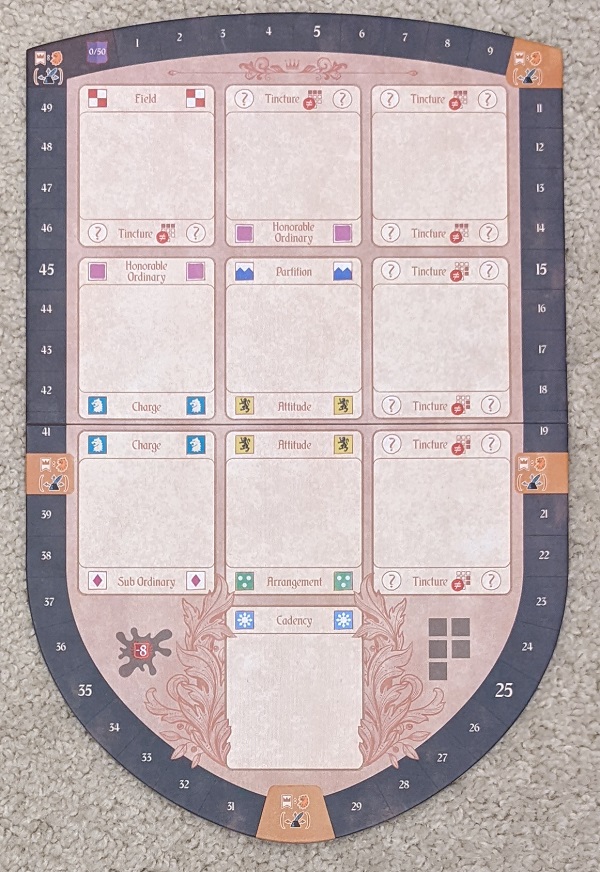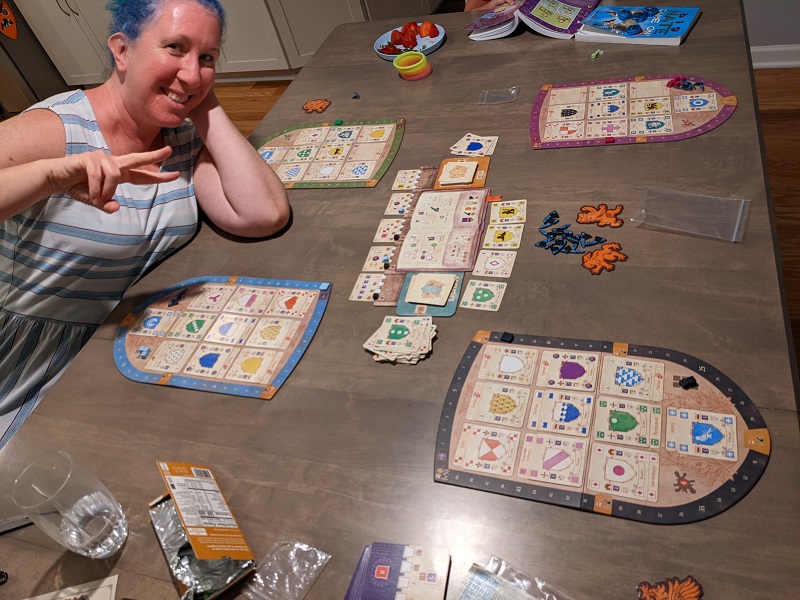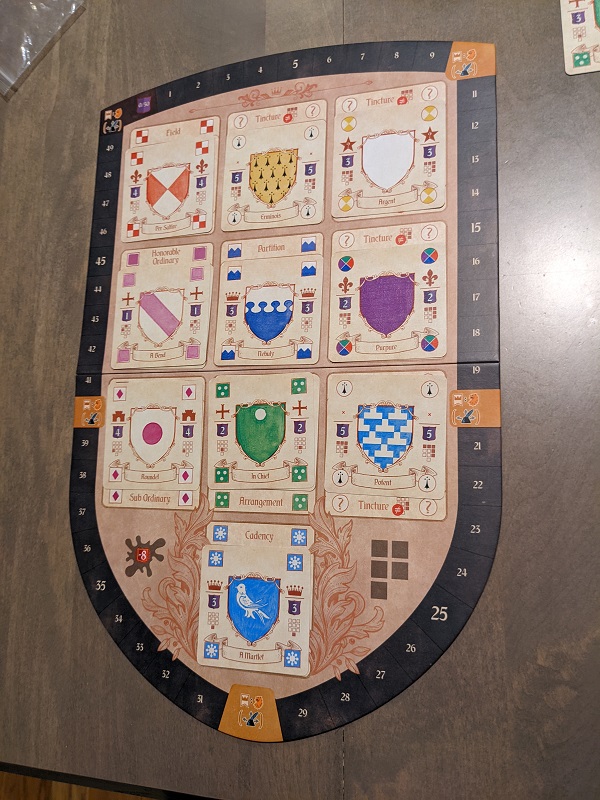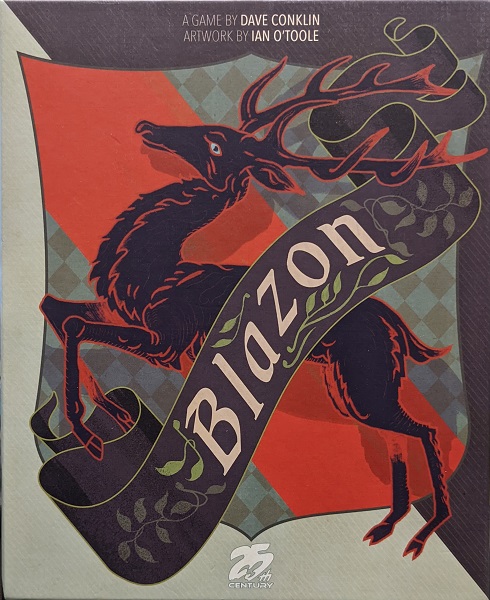When I heard my wife idly mention that someone was doing a boardgame about heraldry, my attention went from dormant to couchant. When I found out it was going to be for sale at GenCon, I became sejant (perhaps even sejant erect, though I’d never admit it in mixed company). Not merely passant, as this was now salient to my interests. When we finally rolled up to the 25th Century Games booth early Thursday afternoon and they only had three copies left, I was rampant!
If this intro made any sense to you whatsoever, then this game is absolutely for you too!
The Device
Heraldry is the ancient art of using various colors, patterns, and symbols to form a “coat of arms,” which was used to uniquely identify members of noble families across Europe during the middle ages. At a time when enclosed helmets were becoming more common, distinguishing friend from foe on the battlefield needed to rely on more obvious means, and heraldry stepped into that void.
Over the intervening centuries, the “rules” of heraldry became more refined and codified, and a whole vocabulary was steadily developed to describe the increasingly complex iconography used to identify the scions of noble houses. This vocabulary was key, because a textual description—a blazon—of the coat of arms needed to be consistent such that any two heralds would describe the same devices the same way. Or could draw them the same way from such a description.
This is the theme of Blazon, and I love it. I am a huge heraldry nerd, having been fascinated by the art since I was first introduced to role-playing games in the mid 1980s. The idea that I could describe the design on my character’s shield the same way knights of old did it really sparked my imagination, and I spent more time than I care to admit fiddling around drawing coats of arms. As such, it was almost a foregone conclusion that I would love this game on theme alone.
But to be a good game these days, you have to deliver more than just theme. There are plenty of well-themed boardgames out there that have awful game-play—too fiddly, too boring, too many moving parts, pick your poison.
Game Play
Fortunately, Blazon delivers from a game-play perspective as well. A competitive game for 1-4 players, the concept is very simple – you are trying to assemble a coat of arms from its various symbolic elements (devices) and colors (tinctures), with each of these having its own deck of cards. On your turn, you may either draw cards or play cards. Easy!
But here’s where things start to get tricky, because the real-life art of blazonry has rules. Certain colors may not appear adjacent to each other, for instance, and certain fields or patterns (called ordinaries) preclude the use of others, and this is where the game-play in Blazon gets interesting.
On each player’s board there are ten slots (three rows of three and a single slot at the bottom). Cards representing devices or tinctures can be played to these slots in one of two orientations, playing to either the “upper” or “lower” position. Whichever way you play, you must match the symbol for the card to the symbol of both the slot and the position (i.e. if you are playing a “Field” card denoted by the red-and-white checked pattern it must be placed in the lower position of the slot in the upper left corner of your board). Further, once you’ve placed a card into a position, all of the other cards played to the same row must be played in the same position (upper or lower). You can change the position for a row, but to do so you must play over all of the cards you’ve already placed for that row in a single turn (which gets progressively more expensive as you complete a row). In the advanced rules you’re allowed to use an “abatement” token to fix things incrementally within a row, but doing so carries a risk – if the game ends and you have not completely fixed the row, you take a pretty substantial hit in terms of victory points.

Ah, yes, points. Each card is worth a certain number of points, and to play a card you must pay for its placement by discarding one or more cards whose sum is of equal or greater value (you can overpay, but you don’t get “change” back if you do). So that 5-point “Rampant” modifier for your animal charge (which itself could range from a 1-point Goat to a 5-point Unicorn) will cost you more to play. Given that the maximum hand limit is seven cards, this can make playing high-value cards tricky. Much like committing to the upper or lower positions, the points values represent opportunity cost. The game end is triggered once a player has completed his or her board, placing cards in all ten slots (allowing one final turn for each of the other players), so playing cheaper cards more quickly may end up working better for you than waiting to play higher value cards. That said, you may find that your completed blazon doesn’t score as highly as someone else’s incomplete board chock full of high-value cards, so it’s a risk either way.
What makes this even trickier are the five “Distinctions” in play (and each category has five potential options, which makes for great replayability). These place additional scoring opportunities for various combinations of cards placed on your board. For example, if “Humility” is in play, you score that Distinction by having three or more 1-point cards on your board, versus “Variety” which you score for having one card of each points value 1 through 5. You gain “Elegance” by having all three varieties of tincture represented. Further, in addition to having a points value, each card has one of five symbols as well (a cross, a castle, a crown, crossed swords, or a fleur-de-lys), and certain Distinctions require certain combinations of these symbols. The first player to score a Distinction gets the most points out of it, and subsequent players get decreasing returns for scoring the same Distinction.
Thus is your conundrum – do you play that 5-point Unicorn and bank the points now, or do you drop a 1-point Sable tincture on your board to get you one step closer to scoring Humility before someone else does (which in a 4-player game would score you 7-points). Decisions, decisions! And that’s what makes the game interesting in play – there’s no real “go-to” winning strategy, and what worked for you one game might not work the next. Sometimes it’s better to go pall-mall and try to finish quickly, but sometimes it’s better to sandbag and maybe pick up an extra Distinction.
There are other scoring opportunities along the way, and a canny player will find ways to take advantage of as many as they can.
Blazon also includes one of the best “catch-up” mechanics I’ve seen in a game of this type: the first time any player either completes a Distinction or crosses a score breakpoint that is a multiple of 10, all of the other players gain a “herald token.” These tokens can be used at any point during a player’s turn to break some of the game’s rules, like being able to take one of the face-up cards in the common marketplace for free, or pull a card from the top of either discard pile, or play a card of any value as though it had a cost of only 1-point. Herald tokens are worth 1VP each at the end of the game, but honestly you’re usually better off using them up in your last turn the obtain or play those few critical cards needed to score you points and/or complete Distinctions. And because you’re getting the tokens immediately when one of your opponents scores, this mechanism really gives the game a “back-and-forth” feel to it – which is great!

Component Quality
Game makers pay a lot more attention to this kind of stuff than they used to, and the component quality in Blazon is quite good. Each player has just a handful of tokens used to track their score and Distinctions (a little shield and cubes respectively) and these are all painted wood. The abatement tokens, herald tokens, and 2-point charges you get for passing a scoring breakpoint are of the same high-quality pressboard as the player boards themselves. The cards are square and of standard thickness with a really nice weave texture to them.
Additionally, the game came with the “bag of bags” that I have come to expect from modern boardgames, such that the various components can be stored easily. If I had any complaint it might be that I wanted a few more small bags, as I feel like it would be nice to store each player’s seven colored components separately, but honestly that’s an incredibly minor quibble.
Solo Play
The game does include a solo-play mode. In this set-up, you are still subject to all the placement rules, but you don’t score points for playing cards to your board. Instead, you are trying to accomplish all 25 Distinctions, with the order of each set of 5 randomized. You must do this before you run out of cards (i.e. would take a turn where you would draw cards and cannot). Because certain combinations of the Distinctions can be impossible to meet simultaneously depending on their order, you end up having to swap from upper to lower position, back and forth until you meet the requirements for one Distinction, then playing over and moving to the opposite position to accomplish the next. I played with one of the increased difficulty settings which prevents you from accomplishing successive Distinctions in the same category until one in a different category has been completed. I won the game on my very last turn (i.e. I had no cards remaining in the draw decks, but was able to play the cards I had in hand to accomplish the final Distinction), Which is pretty much as down-to-the-wire as it gets.
This kind of solo-play is interesting as an efficiency/problem solving challenge, and I’ll definitely play it again, but I certainly prefer the game against human opponents. It’s hard for solo play to capture the same nuance in any game, and in this case it almost feels like a different game entirely.
The Blazon
In our first play of the game as a family I explained to my kids that the final shield was a combination of all the components and colors, and my son asked me what the actual shield would look like. And here one of the cleverest things about the game is that once your board is complete, you can read the cards in order (swapping the order of nouns if you use a sub-ordinary) and it reads as an actual blazon. For instance, here is my board from the four-player game pictured above:

This reads as “Per saltire erminois and argent, a bend nebuly purpure. In chief a roundel potent, in cadency a martlet.” The mark of cadency (which indicates the birth order of the bearer, the martlet in this case being the 4th child) is generally assumed to be white (argent) in color, so I had to add “of the second” to the end. But once I did, you can drop that word for word into the blazon creator at drawshield.net – which is super cool and worth spending some time tinkering around with – and up pops a heraldically correct rendering of my shield:

My design puts a fur on a fur (potent over top erminois) so noted heraldry curmudgeon Arthur Fox-Davies would likely complain at me for breaking the rules, but “false furs” like potent and vair sort of break the rules anyway. Still, the fact that I can take the final state of my game board and read it directly as a blazon is pretty cool, and is a great way for people interested in heraldry to play around and see what different combinations might look like.
Final Thoughts
If you are medieval-nerdy and love heraldry like I do, you will love this game. Game play is relatively speedy – we knocked out a 4-player game with me teaching 3 of the other players in a little over half an hour, and as players learn the rules the game goes even faster. I’ve gotten some 2-player games finished in around 20 minutes. If you’re looking for an easily digestible game that has good mechanisms for keeping the score close, I also think you’ll enjoy this one. And finally, the different combinations of Distinctions add complexity and replayability, which is one of the things I really look for in a game.
Overall this one gets an enthusiastic thumbs up from me, and I look forward to getting it in front of more of my RPG buddies who share my interest in the theme.


